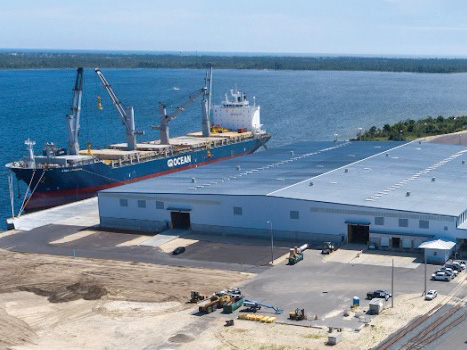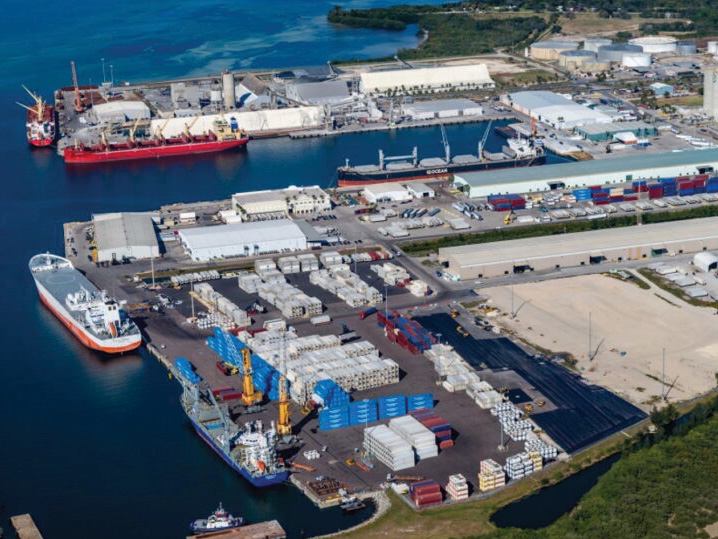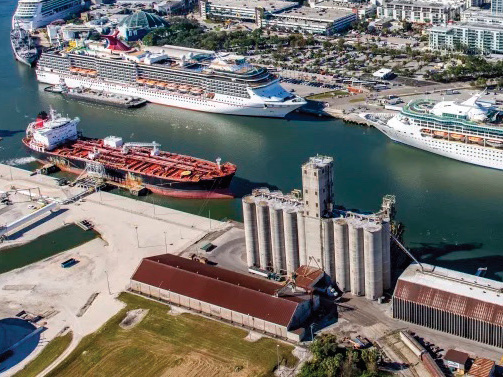Florida’s ports are growing fast. The State’s container ports are being buoyed by both the shifts to the East Coast from Asia via the Suez Canal and proximity to the Panama Canal for Transpacific freight. Auto processing is also growing and is breakbulk cargo, especially forest products. And cruise ships are back, and the numbers are growing past pre-pandemic tallies.

Port Panama City
For Port Panama City, like many of Florida’s ports, fiscal year 2022 was a record breaker.
Port Panama City, like other Florida ports, benefited from clear terminal and a shift in freight as shippers tried to dodge supply chain disruptions occurring in other parts of the country – notably the West Coast. Alex King, executive director, Port Panama City noted in his review of the results, “While much of the country spent last year dealing with supply chain disruptions, Port Panama City was focused on securing additional cargo that would normally move through gateway ports in other states. Our port has become an attractive option for break-bulk forest products and other cargoes.”
In many respects Port Panama City became a “breakbulk” port alternative for many shippers. Indeed, Port Panama City handled more than 450,000 tons of break-bulk forest products and lumber in 2022, with 230,000 tons of that cargo moving through the East Terminal which opened for operation in 2020.

Besides the East Terminal with its 260,000 sq/ft warehouse and 900 foot bulkhead, the Port has made a number of recent investments in its infrastructure. These include a biomass bulk dome on the 138-acre West Terminal; an Intermodal Distribution Center (IDC) Site Development for additional on-site tenants; development of a FedEx Ground Regional Distribution Center at the IDC and a 70,000 sq/ft on port Container Freight Station (CFS) West Terminal to the growth in container business with Mexico.
Mexico has been another bright spot for the Port. In 2022 King represented the Florida Ports Council on an Economic Trade Mission to Mexico. For Port Panama City that has translated into a 10% increase in trade.
In January 2023, the Panama City Port Authority board approved a plan to expand the East Terminal by adding an additional 27 acres to the existing 54 acres. James Cook, the board chairman, elaborated on the plan saying it would double the terminal’s capacity. The additional land would enable the berth to be expanded to 900 feet. Currently, the terminal can handle one-ship and averages only one or two ship calls a month. The pier expansion would allow the Port to handle two ships at a time and also provide the space for more warehousing.

SeaPort Manatee
SeaPort Manatee offers a diverse menu of services including 10 deep-draft berths that handle container, liquid, and dry bulk, breakbulk, heavylift, project and general cargo that along with its Gulf location is one of the closest US ports to the Panama Canal and has boosted the Port’s attraction to shippers and carriers alike. In Fiscal Year 2022 [FY ending in Sept. 30, 2022] SeaPort Manatee, like Port Panama City to the northwest, posted a record breaking year. Containerized cargo surged nearly 35% amounting to 1,363,106 tons and hit a record 177,108 TEUs in FY 2022, up 30.6% over FY 2021 – and impressively, more than doubled the SeaPort Manatee’s TEU total in FY 2020.
The container sector was boosted by temperature-controlled cargo. In FY 2022 the Port handled 420,582 tons of containerized fruits and vegetables, an increase of 24.6% from FY 2021 with cross-Gulf services of SeaPort Manatee-based World Direct Shipping and Latin American services of Coral Gables, Florida headquartered Fresh Del Monte Produce Inc. carrying most of that volume. Chiquita also began calling at the Port through chartering space on Del Monte ships. In addition, 520,212 tons – or nearly 125 million gallons – of fruit juice came through SeaPort Manatee, up 14% from 2021.
Overall cargo tonnage also boomed as the Port hit a record high of 11,030,762 tons, a 5.5% increase over FY 2021. And the real winner for SeaPort Manatee was the breakbulk sector which posted a 39.7% increase to 807,632 tons. Forest products were a significant contributor to the Port’s record year. The Port posted a 73.1% leap in tons of plywood and particle board and a 52% rise in wood pulp tonnage. Overall forest products throughput skyrocketed nearly 41%, to 472,970 tons, in FY 2022. While other sectors have grown significantly, petroleum products remain the largest commodity sector at SeaPort Manatee with 1,493,883 short tons moving through the port in FY 2022, up 18.6% from FY 2021.
The Port is also working on improving its infrastructure, as Reggie Bellamy, chairman of the Manatee County Port Authority pointed out, “Working closely with industry partners in sustaining record levels of commerce, SeaPort Manatee continues to enhance its infrastructure, including through ongoing expansion of dockside container yard facilities, while offering more than 5,000 acres of on-and near-port properties for future development.”
Among the improvements made during 2022, SeaPort Manatee and terminal operator Logistec USA Inc., (a subsidiary of Logistec Corp) added two new Konecranes Gottwald Generation 6 mobile harbor cranes. The eco-efficient cranes arrived at SeaPort Manatee on April 22, 2022, via trans-Atlantic vessel voyage from Germany. Each of the cranes is capable of lifting loads of as many as 125 metric tons, and the two units combine to offer a tandem lift capability of more than 200 metric tons – the most at any Florida seaport. In addition, the Port inked a deal under which Port Manatee Railroad LLC is to be operated as a subsidiary of Kennett Square, Pa.-based Regional Rail, which already operates seven other U.S. short line railroads, including three others in Florida, with more than 550 total miles of track. Regional Rail LLC will operate the seaport-owned short line railroad through at least 2036 with options through 2051.

Port Tampa Bay
A lot has happened at Port Tampa Bay over the last two years plus. It is worth taking a look back to March 14th, 2020, when all cruise activity at the Port ceased following the Center for Disease Control and Prevention issue of a No Sail Order. In FY 2021 Port Tampa Bay had no cruise ships, no cruise passengers, and importantly no cruise revenue. But since the resumption of cruise activity in FY 2022 the Port has boomed.
In December, Port Tampa Bay set a record with seven cruise ships calling in a five day period. For the year the Port estimates that a record 1.2 million passengers called at Tampa Bay. And that means a lot to the authority and the Tampa Bay region. According to a study by Business Research & Economic Advisors on cruise tourism, a 2,500-passenger cruise vessel with a 1,000-person crew has an economic impact on a homeport of approximately $330,000 per call. The total economic impact of Port Tampa Bay’s cruise business shows the port’s cruise business brings an annual economic impact of approximately $627.8 million and accounts for nearly 20% of the port’s revenue.
Of course, Port Tampa Bay is a great deal more than a cruise port. Port Tampa Bay is the largest port in the state of Florida by tonnage and by acreage. Port properties encompass 5,000 acres and are located across six main areas in Hillsborough County (Channelside, Hookers Point, Eastport, Port Ybor, Port Sutton and Port Redwing). It is arguably Florida’s most complex port as well with a diversified cargo mix that includes bulk, breakbulk, roll-on/roll-off [auto] and container terminal operations spread over the wide port range.
An example of just how diversified the cargo business is occurred when Port Tampa Bay recently received several large dragline buckets used by The Mosaic Company for its phosphate operations in Central Florida. Phosphate fertilizer is one of Florida’s leading export commodities with a 2020 value totaling $1.4 billion. In many respects the move represents the heavy lift component inbound, and the potential bulk export side of what Tampa has to offer beyond container shipping and the cruise industry.
The Port is also expanding by leap and bounds and got a big boost from the US DOT. Port Tampa Bay will receive $12.6 million in grant funding, from the US DOT to expand and diversify a berth at Port Redwing. The port’s funding allocation is part of $1.5 billion in grant funding made available through the Rebuilding American Infrastructure with Sustainability and Equity (RAISE) discretionary grant program. Tampa will use RAISE funding to create Berth 301 at the satellite facility, Port Redwing. The new berth will provide room for a third large ship to be worked at the Port. Anderson said of the grant, “The berth 301 project will have a generational impact on our community in terms of economic development...” Additional private investment and investment from Port Tampa Bay will be added to the grant’s funds. Besides Redwing, there is a terminal expansion underway which includes increased storage to 97 acres from 67 acres, berth expansion to 4,500 feet from 3,200, an additional new gate, and three new gantry cranes.
The port anticipates completion of $78.3 million in capital improvement projects in 2023. At $35.4 million, Hooker’s Point Development is the largest component of the capital plan and includes berth and road improvements.




